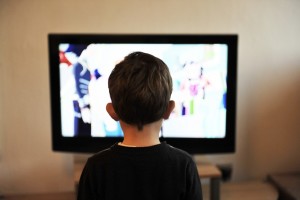How do teens exposed to a lot versus a little sexual media differ?
Gone are the days when Lucy and Desi of “I Love Lucy” slept in separate beds. Instead, television shows containing nudity and sexual scenes, such as “Empire”, “Scandal”, or “How to Get Away with Murder,” have become more commonplace. Perhaps it’s not surprising, then, to hear that the amount of sexual content in the media has increased in the 21st century.[1]
In our Growing up with Media study, we found that most youth (47%) are exposed to a LOT of sexual content – they said that many, almost all, or all of at least one type of media they consume depict sexual situations like people kissing, fondling each other, and having sex. Conversely, very few – less than one in ten (8%) – report low exposure to sexual content.
Viewing violent media seems to be associated with violent behavior,[2,3] whereas viewing pro-social media is associated with positive behavior.[4] It seems plausible that this relationship could be true for sexual content too, right? Among the 14- to 21-year-old youth in the Growing up with Media study whose media consumption had almost no or no sexual content at all, only 2% had ever had sex. In contrast, among youth who stated that most or all of the media they consume contain sexual content, 60% of them reported sexual activity. Interestingly, the average age of these two groups did not differ. In other words, the reason we’re seeing what we’re seeing is not because older youth are both more likely to consume sexual media and also be sexually active. Sexually active youth who consumed the most sexual media were also less likely to regularly use condoms compared to those who consumed the least amount of sexual content in media. While it’s not clear from this study if we are seeing these trends because youth who have more sex are more likely to seek out sexual material or if it is because sexualized media is causing youth to become more sexually active, there definitely appears to be a relation between the two.
So, can anything be done about this? Absolutely! We can be more involved in teens’ media consumption, discuss the content with them, and use our conversation as an opportunity to share our healthy values about sex with them. In doing so, not only do we help young people understand the positive and negative aspects of being sexually active as a young person, but we also help them see the differences between themselves and the television characters they are viewing [5].
This article is based on Ybarra ML, Straburger VC, Mitchell KJ. Sexual media exposure, sexual behavior, and sexual violence victimization in adolescence. Clin Pediatr. 2014;53(13):1239-1247. doi: 10.1177/0009922814538700
Learn more about our research at Center for Innovative Public Health Research.
Find us on Twitter, Facebook, and Google+.
Thank you to Dr. Myeshia Price-Feeney and Ms. Emilie Chen for their contributions to this blog.
References:
[1] Ballie R. Study shows a significant increase in sexual content on TV. 2001; http://www.apa.org/monitor/may01/sexualtv.aspx
[2] Bushman B, Huesmann LR. Short-term and long-term effects of violent media on aggression in children and adults. Arch Pediatr Adolesc Med. 2006;160(4):348-352.
[3] Anderson CA, Shibuya A, Ihori N, et al. Violent video game effects on aggression, empathy, and prosocial behavior in Eastern and Western countries: A meta-analytic review. Psychol Bull. 2010;136(2):151-173. doi: 10.1037/a0018251.
[4] Prot S, Gentile DA, Anderson CA, et al. Long-term relations among prosocial-media use, empathy, and prosocial behavior. Psychol Sci. 2014;25(2):358-368. doi: 10.1177/0956797613503854.
[5] Brown JD. Media literacy has potential to improve adolescents’ health. J Adolesc Health. 2006; 39:459-460.

